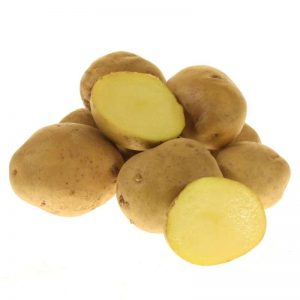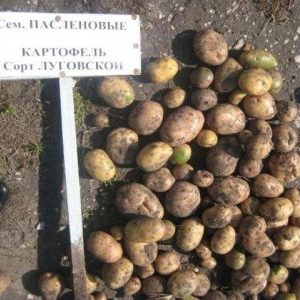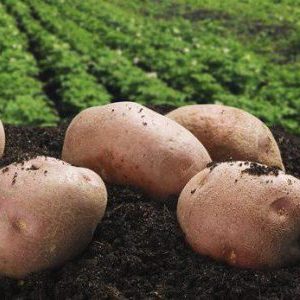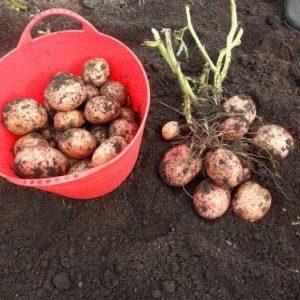Mid-season, high-yielding potato variety "Lugovskoy", ideal for mashed potatoes
The Lugovskoy variety is successfully cultivated by farmers both on private summer cottages and on large farms. The choice of gardeners in favor of this particular crop is due to its high yield, taste, resistance to an unfavorable climate and diseases characteristic of the culture. Read about the other advantages of the variety and the features of its cultivation in our article.
The content of the article
Description of the variety

Lugovskoy potatoes belong to table varieties. Its tubers are good boiled over and are ideal for stewing, preparing baby food, salads and soups. The cultivation of this variety for industrial purposes involves the processing of root crops into freeze-dried puree.
Origin and development
The variety was bred by Ukrainian breeders in 1987 on the basis of Sineglazka potatoes. Patented by the Ukrainian Potato Institute, the selector department of the Academy of Agrarian Sciences.
Chemical composition, trace elements and vitamins
Root crops, depending on the fertility of the soil, contain 12-19% starch, a lot of protein and amino acids, carotenoids and vitamins of group B and C.
Ripening period
Lugovskoy is a mid-season potato variety. Between landing tubers and the readiness of the crop for harvesting takes an average of 70-80 days.
Yield
A consistently high yield is the main value of the variety. 10-15 tubers can be harvested from a bush, and during varietal tests, an indicator of 514 centners / ha was officially recorded.
Disease resistance
The variety is resistant to fungal diseases and is extremely rarely affected by potato crayfish, black leg or scab, and due to the early ripening period, the plant is not afraid of late blight. Moreover, in the case of excessive soil moisture, there is a risk of infection with Alternaria and Fusarium.
Characteristics of tubers, description of appearance
Bushes are erect, compact, with a well-developed root system, moderately spreading stems and an average number of leaves.
The leaf plates are small, dark green, have distinct veins and slight pubescence. During a short flowering, large white or cream flowers appear on the bushes, forming a compact corolla. The berries are large, light green, but they are rarely tied and fall off quickly.
The tubers are large, weighing an average of 100-130 g each, oval, the top is blunt and round. The skin is thin, glossy, light pink in color. On the surface there are a few small, recessed eyes.
The pulp is white, has a pleasant taste, and boils well when cooked.
What regions are best suited for and climate requirements
Lugovskoy potatoes adapt well to climatic conditions and are suitable for growing in the Northern, North-Western, Central, Volgo-Vyatka, Central Black Earth, North Caucasian, Nizhnevolzhsky, Ural, West Siberian, East Siberian and Far Eastern regions.
The main advantages and disadvantages of the variety
The Lugovskoy potato variety has a number of undeniable advantages, among which they are especially distinguished:
- great taste;
- early maturation;
- good keeping quality and transportability;
- the content of many useful elements in root crops;
- resistance to typical diseases;
- consistently high yield;
- resistance to mechanical damage;
- frost resistance;
- undemanding to care and weather conditions;
- lack of tendency to degeneracy;
- the minimum amount of small and ugly fruits.
The variety has practically no disadvantages. Farmers note only its sensitivity to soil nutrition and watering - an excess of moisture leads to potato decay.
What is the difference from other varieties
| Variety | Ripening terms | Productivity, t / ha | Starch content,% | Mass of marketable tubers, g | Keeping quality,% |
| Lugovskoy | 70-80 days | 51,4 | 13-19 | 100-130 | Up to 97 |
| Santana | 80-95 days | 16,4-38,4 | 13,4-17,3 | 96-168 | 92 |
| Desiree | 80-96 days | 13-38 | 14-23 | 50-100 | 95 |
| Openwork | 75-85 days | 45-50 | 14-16 | 95-116 | 95 |
| Tuscany | 70-90 days | 46 | 12-14 | 90-125 | 93 |
| Purple Haze | 90-110 days | 18,2-30,9 | 14,4-17,2 | 90-160 | 98 |
| Aurora | 60-80 days | 30-40 | 13-17 | 90-130 | 94 |
Features of planting and growing
For planting and growing Lugovskoy potatoes, in general, standard agricultural rules are applied.
Preparing for landing
For planting, it is necessary to select high-quality seed: medium-sized sprouted tubers that do not have traces of rot, stains and any other defects.
Reference! For germination, tubers should be placed in a warm, well-lit place with a temperature of +20 ... + 25 ° C for 30 days.
24 hours before planting in the soil, the tubers should be disinfected and treated with fungicides (Bordeaux liquid, copper oxychloride, "Maxim"), dipping them into the selected solution for 30 minutes. Treatment of tubers with "Epin" or "Kornevin" will be useful for productivity and resistance to diseases.
In the fall, the selected plot of land is dug up and fertilized with organic matter, and in the spring it is loosened and freed from weeds.
Ground requirements
Lugovskoy is undemanding to the ground. In heavy loamy soil, it will not be possible to get a bountiful harvest, but in the soil lightened with sand, enriched with humus and fertilized with humus, wood ash or peat, the yield increases markedly.
Timing, scheme and landing rules
Tubers are planted when the soil warms up to + 10 ... + 12 ° C, otherwise the risk of rotting increases. In the south, this is the end of April - mid-May, in the Urals and Siberia - the end of May - early June, and in the Moscow region and the Middle zone - the beginning - end of May.
Lugovoy's landing pattern is standard:
- draw on the site even in-depth rows at a distance of 70 cm from each other;
- dig holes 10-15 cm deep along the rows every 35 cm;
- pour 0.5 kg of humus and 0.5 cups of wood ash into them;
- lay seed in the pits to a depth of no more than 15 cm;
- fill and level the soil.
Reference! When planting potatoes in regions with a warm climate, the depth of the hole can be 10 cm, in cold regions - 15 cm.
Growing features
Basic rules for the cultivation of the Lugovskoy potato variety:
- choose a well-lit place for planting, where there are no drafts and stagnant moisture, and the groundwater lies at a depth of at least 2.5 m;
- change the planting site annually, and if this is not possible, then sow the soil after harvesting with siderates;
- give preference to light, fertile soil, despite the unpretentiousness of the variety.
The nuances of care
The key to high yields and high-quality, large fruits is compliance with agrotechnical norms and rules.
Watering mode
Potatoes are watered with settled water, the temperature of which is equal to the ambient temperature, so that the soil is moistened about 50 cm in depth.
Under favorable weather conditions and sufficient precipitation, it is enough to water the plants three times during the entire growing season:
- when the green part rises 10-15 cm above the ground, with earlier moistening, the growth of surface roots begins, causing a constant moisture deficit (4 liters of water for each bush);
- at the beginning of flowering;
- right after it.
Reference! It is necessary to water the potatoes fractionally, pouring out water in portions after the previous part has been completely absorbed by the earth.
Top dressing
You need to fertilize potato bushes at least twice a season. During budding, foliar dressing with Bitoxibacillin, Lurastim, Fitoverm or Akarin is useful - this helps to increase the yield and immunity of the plant.
During the season, mullein, bird droppings, potassium and magnesium sulfate, superphosphate and complex mineral fertilizers are also used.
It is important to ensure that the fertilizer does not contain urea and that the nitrogen content is maximum 10%. These substances contribute to the growth of green mass and inhibit the development of root crops.
Weeding and hilling
The first hilling of bushes is carried out after the emergence of shoots, and then after each watering or rain. This contributes to the elimination of weeds and the creation of a favorable temperature regime, humidity and oxygen levels, which has a good effect on the development of root crops.
Weeding is started after the emergence of strong and strong shoots. The soil is cultivated between the rows, repeating the procedure about three times every two weeks if necessary.
Disease and pest control
How to avoid disease and pest attacks:
- carefully select tubers for planting and use only healthy, undamaged potatoes;
- disinfect and treat tubers with insecticides before planting;
- take into account the crop rotation, follow the irrigation rules and harvest the crop in a timely manner;
- lay onion husks and wood ash in the planting holes.
In case of development of diseases, the bushes are treated with fungicidal preparations "Fitosporin", "Maksidom", "Kuproksat", "Artsdil".
Among the pests, the greatest danger to Lugovsky is represented by Colorado beetles, aphids, spider mites, cicadas, potato flies, bears and wireworms. In the fight against insects will help insecticides "Commander", "Fitoverm", "Vermitek", "Calypso", "Karbofos", "Lepidocid", "Regent", "Actellik".
Harvesting and storage
Harvest immediately after the tops turn yellow, wither and fall. Approximately 7-10 days before digging up the potatoes, they mow it - this will increase the nutritional value of the tubers.
How and when to collect

The first root crops are dug up in the middle of summer, but the full harvest is carried out in late August-early September, in warm and dry weather. It is important to dig up the tubers on time, otherwise they may lose their taste or become infected with late blight.
Storage features and keeping quality of the variety
The dug tubers are laid out in the sun for 2-3 hours to dry, and then sorted, getting rid of damaged and rotten potatoes.
The best root crops are laid out in boxes, bags or nets and sent to storage in a dark room with good ventilation, humidity 80-90% and temperature + 13-18 ° C. The temperature is gradually lowered until it reaches + 2 ... + 4 ° C. Under these conditions, potatoes do not wrinkle or soften until the next harvest. Keeping quality of Lugovsky - up to 97%.
What can be the difficulties in growing
When growing Lugovsky, the following problems are most likely:
- decay of root crops due to excessive watering;
- the development of Alternaria and Fusarium with late harvesting;
- low yield when growing potatoes in heavy loamy soil.
You can minimize or completely avoid such problems if you follow the rules for caring for potatoes.
Reviews about the variety Lugovskoy
The advantages of the variety make Lugovskoy practically the number 1 choice for Russian gardeners and collect only positive reviews:
Alexander, Orsk: «An excellent variety, I have been growing it for more than 5 years, and every year it pleases with a bountiful harvest and quality of tubers that grow large, even. The only negative is that it is affected by Colorado beetles, but this is a problem for all potato varieties. "
Larisa, Volzhsk: “We grow potatoes not only for ourselves, but also for sale. Only 6 varieties, including Lugovskoy. At first we planted it quite a bit, but we are constantly increasing the volume, because it is in demand - the tubers are tasty, look perfect, keep well and tolerate transportation. "
Mikhail, Tver: “For about 10 years I have only grown Lugovskoy. A neighbor advised me this variety, for which many thanks to him. Even the thought was not to replace the variety with some other - I do not see any need for this. Of course, the fight against Colorado beetles is annoying, not without it, but in my memory there is no strain that would not interest these insects. "
Read also:
The hardy potato variety "Lapot" is not afraid of bad weather.
Conclusion
Lugovskoy is one of the most popular potato varieties. Consistently high yield, pleasant taste, immunity to a number of diseases and unpretentiousness to care with good keeping quality and excellent commercial qualities of tubers - far from all the advantages of the variety, thanks to which gardeners prefer it.